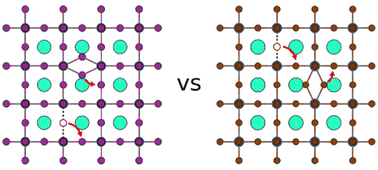How fast do defects migrate in halide perovskites: insights from on-the-fly machine-learned force fields†
Abstract
The migration of defects plays an important role in the stability of halide perovskites. It is challenging to study defect migration with experiments or conventional computer simulations. The former lacks an atomic-scale resolution and the latter suffers from short simulation times or a lack of accuracy. Here, we demonstrate that machine-learned force fields, trained with an on-the-fly active learning scheme against accurate density functional theory calculations, allow us to probe the differences in the dynamical behaviour of halide interstitials and halide vacancies in two closely related compositions CsPbI3 and CsPbBr3. We find that interstitials migrate faster than vacancies, due to the shorter migration paths of interstitials. Both types of defects migrate faster in CsPbI3 than in CsPbBr3. We attribute this to the less compact packing of the ions in CsPbI3, which results in a larger motion of the ions and thus more frequent defect migration jumps.

- This article is part of the themed collection: Perovskites


 Please wait while we load your content...
Please wait while we load your content...